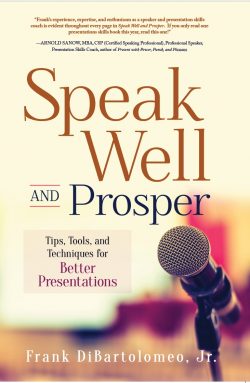How Good Are Your PowerPoint Slides?
Dateline: Centreville, VA

“Presentations aren’t about the presenter; they’re about the audience and what the audience needs. If the presenter is talking too much it’s usually a sign that he or she has forgotten who’s important.”
– Simon Raybould, speaker, author, and presentation expertAfter reading these articles for a while, you know you are the message of your presentation. Your slides are support, nothing more.
However, your slides can significantly support your presentation or be a distraction.
In the article, 4 Tips and 1 Tool That Will Help You Perfect Your Slide Design by Alexa Harrison, she outlines tips for perfecting your slides. Below, I cover three of them in excerpts from Ms. Harrison’s article in quotes.
Design Slides that Communicate a Single Idea
“Always keep in mind your ultimate goal: making your information easy to digest and understand. Trying to say too much will confuse your audience and cause you to fail the Glance Test from the start. Restraint is crucial:”
-
“On the macro-level, always know your Big Idea. We’re talking about the goal of the presentation. This is also called the controlling idea, the gist, the takeaway, the thesis statement. Every single piece of content needs to support this larger mission, so double-check that it does.”
-
“Limit yourself to one idea per slide. Break up complicated, multi-part concepts on separate slides and eliminate distractions for the audience by directing them to focus on key messages and data. Remember, if the information doesn’t directly ladder up to your big idea, kill it.”
Communicating one idea per slide is crucial to “making the slide pay for itself.”
Have you ever seen slides that don’t have a consistent visual style? You wind up trying to figure out the speaker’s point from the slide and missing what the speaker is saying.
Design your slides simply and with a consistent visual style.
Design Simple Slides with a Consistent Visual Style
“This might seem obvious, but every presentation should be designed with your audience in mind. However, it gets deeper and more specific than you might anticipate.”
“Every slide, every piece of information you’re presenting should attempt to speak to your audience’s needs, concerns, and fears. You want to talk to them in a way that builds trust and establishes emotional connections.”
“You want to anticipate their questions and their resistance. Many people take the audience into account on a macro level, but if you’re committed to your audience, you’ll keep a persona slide at the beginning of your deck as you’re designing your presentation. Then you can refer to it as you’re editing each slide.”
So you must communicate one idea per slide and design your slides simply and with a consistent visual style.
It is also essential to arrange your layout and slides with care.
Arrange Your Layout and Slides with Care
“When you create your slides, pay special attention to how you arrange elements. Arranging them haphazardly can obscure meaning and confuse the audience. Here are several aspects of arranging you should focus on when designing your slides:”
-
“Flow: Think about how viewers’ eyes will move around a slide. They might notice the biggest and brightest elements first, then move to the other slide elements.”
-
“Contrast: Human eyes are drawn to things that stand out. Thus, you can use contrast to focus the audience’s attention. Contrast slide elements using size, shape, color, and proximity.”
“White space: White space is just what it sounds like – the white, open space around a slide’s items of interest. Include a healthy amount of white space on your slides. This helps sharpen viewers’ focus by isolating the important elements.”
Ensure you communicate one idea per slide, design simple slides with a consistent visual style, and carefully arrange your layout and slides.
Slides have been around for a long time, but great slides are rare.
Make sure your slides are great rare ones!
Call to Action
Ensure your slides
“The best text slides convey their message as starkly and simply as possible. They do not waste words (or slides) on transitional or introductory points, which can and should be stated orally. This means of course that the slides by themselves will not be intelligible as a handout to someone who has not attended the presentation.”
? Barbara Minto, The Minto Pyramid Principle: Logic in Writing, Thinking, & Problem SolvingFrank DiBartolomeo is a retired U.S. Air Force Lieutenant Colonel and award-winning speaker, presentation and interview skills coach, and Professional Member of the National Speakers Association. He was awarded Toastmasters International’s highest individual award, Distinguished Toastmaster because of his outstanding work in public speaking and leadership.
Frank formed DiBartolomeo Consulting International (DCI), LLC (www.speakleadandsucceed.com) in 2007. The mission of DCI is to help technical professionals to inspire, motivate, and influence their colleagues and other technical professionals by improving their presentation skills, communication, and personal presence. Reach Frank at frank@speakleadandsucceed.com and (703) 509-4424.
Don’t miss Frank DiBartolomeo’s latest book!
“Speak Well and Prosper: Tips, Tools, and Techniques for Better Presentations”

Available now at Amazon.com and BarnesandNoble.com
source http://www.expertclick.com/NewsRelease/How-Good-Are-Your-PowerPoint-Slides,2023297937.aspx
Comments
Post a Comment